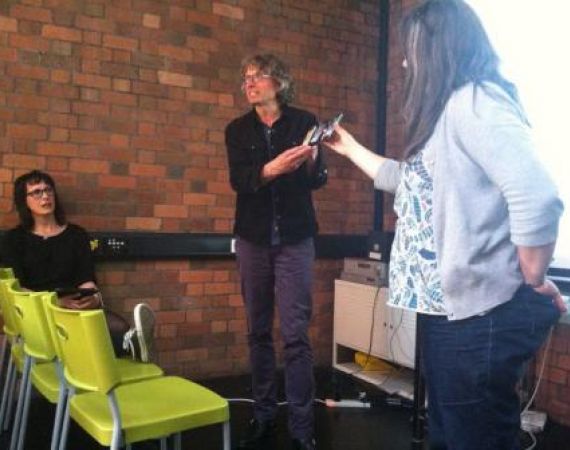Posted on Fri 7 Jun 2013
The Nth Screen with Tim Kindberg and Charlotte Crofts: Lunchtime Talk Write-Up
On Friday 1 May we were treated to a fantastic Lunchtime Talk by two of our Studio Residents, Tim Kindberg and Charlotte Crofts about their REACT funded project The Nth Screen. Studio resident Tim Kindberg has been working on multi-screen apps for some time - from back in the 80s, actually, when he…

On Friday 1 May we were treated to a fantastic Lunchtime Talk by two of our Studio Residents, Tim Kindberg and Charlotte Crofts about their REACT funded project The Nth Screen.
Studio resident Tim Kindberg has been working on multi-screen apps for some time - from back in the 80s, actually, when he did his PhD on Reconfigurable Distributed Computations and more recently with Steve Chamberlain on Heads, and on It’s the Skin You’re Living In with theatre company Fevered Sleep.
Charlotte Crofts is Senior Lecturer in Film Studies and Video Production at UWE. Her research interests lie in the aesthetics of narrative film, with a particular interest in editing, as well as in how digital technologies have impacted on aspects of the film industry, from production and post production to exhibition and cinema heritage.
Recently Tim and Charlotte were awarded funding from REACT's Pump Priming scheme to develop Tim’s Nth Screen project. The Nth Screen is a multi-device, multi-segment film for people to enjoy and discuss together in social, co-located groups. Each participant unlocks part of the film by connecting their device. The other devices respond to their presence, to reveal further film segments. Tim began the talk by explaining to us they wanted to explore how film viewing becomes social and communal, building upon the desire to be together, whether in public, at the dining table or in front of the TV.
Tim and Charlotte then showed us a demo of two short videos Tim has created to demonstrate the capabilities of the application. The first was a short holiday video Tim had shot showing the passing riverbank from a boat; as Tim and Charlotte held three phones up we watched the house on the riverbank move from screen to screen. The second was a spoof Meerkat video, where characters invite you to fetch other people to view more content, and interact with each other by passing objects from phone to phone. These simple videos showed the capability and potential for the application, and helped them secure the REACT funding.
With the REACT funding secured Tim and Charlotte decided to run a two-day workshop with filmmakers to explore how to create content for The Nth Screen. The workshop was a great success and helped raise some interesting things to consider when designing for The Nth Screen:
Designing for play – You can’t control what the audience is going to do, or how they are going to view or position the videos. They identified that early testing would provide the best feedback for the successfulness of content produced over this medium.
Synchronisation – As the synchronisation programme runs over Wi-Fi they are typically just a few milliseconds out of sync. However if you have a poor network this can grow to a second or more. When it’s not planned for it can become an issue but if the filmmakers are aware they can use this as a feature rather than a problem.
Timing – They discovered that the optimum video length seemed to be between 30-90 seconds.
One of the main things they discovered by running the workshops was how enjoyable and fun it was to actually create the video content for multiple screens in collaboration with others. Tim explained they are now thinking about making a click and shoot version so people can create their own multi screen videos easily.
What Next?
Tim and Charlotte will now work with fellow Studio resident Hazel Grian to produce a short Nth Screen feature to show off the capabilities of the application. Hazel is a writer, director and performer in theatre and film, with a passion for storytelling using emerging technology. You can find out more about The Nth Screen and follow the project development on Tim’s blog here: http://matter2media.com/2013/news/the-nth-screen